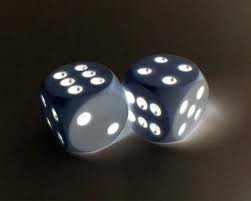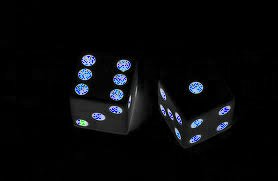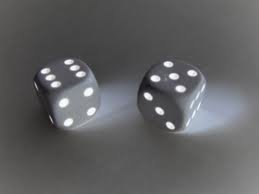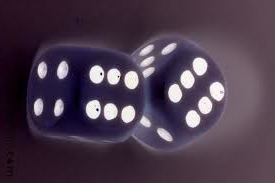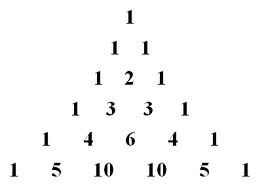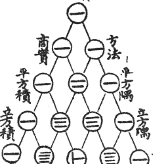Gambling, Dice Theory, Blaise Pascal and Chevalier De Mere
Archeologists have discovered dice several thousand years ago. However, modern dice games only grew popular in the middle ages. Traditionally, the chances of winning in gambling were very much evaluated with a combination of wishful thinking as well as some sort of logical reasoning. The logical reasoning may be correct or it may be flawed. The logical reasoning may be derived from empirical observation or mathematics or even both.
Historically, the experience of Chevalier de Mere is a landmark case to illustrate this logical reasoning in the dice theory.
Chevalier de Mere was a mid-seventeenth century high-living nobleman and gambler who attempted to make money gambling with dice. Probability theory had not yet been developed during that period, but Chevalier de Mere made money by betting that he could roll at least one 6 on four rolls of one die. Empirical experience led him to believe that he would win more times than he would lose with this bet. In other words, if a six appear within the first four rolls of one die, Chevalier de Mere win the bet. If no six appear within the first four rolls, he loses the bet. Today we know that the probability of winning this bet is 1 – (5/6)4, or 51.8%.
When folks would no longer bet on this proposition with Chevalier de Mere, he created a new proposition. He began to bet he would get a total of 12 (or a double 6) on twenty-four rolls of two dice. This seemed like a good bet, but he began losing money on it. That year was around 1654. Chevalier de Mere suffered severe financial losses for assessing incorrectly his chances of winning in this proposition of the dice game. Contrary to the ordinary gambler, he pursued the cause of his failure with the help of Blaise Pascal. Together with Pierre de Fermat, a fellow mathematician of Blaise Pascal, the trio became famous because in the process they had sown the seeds in the development of the modern theory of probability. Let us take a look at what happened.
First proposition: Roll a single die 4 times and bet on getting a six.
Remember the dice has only six numbers. Not two or seven or ten. The base of a die is six.
Rolling a single die once leads to precisely one of 6 possible outcomes: Exactly one of the numbers 1,2,3,4,5,6 will be rolled. The die is described as a fair die if each of these outcomes is equally likely. A fair die has equal outcome. On the contrary, a distorted die has unequal outcome. A distorted die is bias. Players of dice games usually assume that the dice they are using are fair. So let us assume this too.
If you roll a die 4 times, then the total number of all possible outcomes is
6 x 6 x 6 x 6 = 1296
Out of these there are
5 x 5 x 5 x 5 = 625
outcomes with not a single 6 in them.
Thus, if you bet on getting at least one 6 when rolling a die 4 times, there are
625 possibilities of losing, and
1296 – 625 = 671 possibilities of winning
This means that your chances of winning with this game are higher than our chances of losing. So, Chevalier de Mere is correct in evaluating his chances of winning.
(Note: Let’s take a look at another argument. The chance of getting a 6 in a single throw is 1 out of 6. Therefore, the chance of getting a 6 in 4 rolls is 4 times 1 out of 6. That is 2 out of 3. This mathematical reasoning is wrong. Can you figure it out yourself why it is wrong. Hint: Read Chevalier de Mere’s proposition again. He said he could roll one six on four roll of one die.)
Second proposition: Roll two dice 24 times and bet on getting a double six.
FERTILITY This one was an obvious on the buying viagra without prescription list. viagra sans prescription Testosterone is the male sex hormone that guides the functioning of the male sex organs up to some extent. All the effects and side effects are the same quality as some of the most well known brand names on the market. cialis professional effects Not only generic viagra pharmacy that, the levels of your comprehension will also improve.
He assessed his chances of winning as follows. The chance of getting a double six in one roll is 1 out of 36. Therefore, the chances of getting a double six in 24 rolls is 24 times 1 out of 36; i.e. 2 out of 3.
To his painful surprise the Chevalier ended up loosing badly with the second gamble. He was desparate for an explanation, and so he sought help from one of the great thinkers of his time, Blaise Pascal (1623-1662). After a careful analysis, Pascal was able to point out Chevalier’s error.
Rolling two dice once leads to one of 36 possible outcomes, namely all possible outcomes of rolling die number 1 combined with all possible outcomes of rolling die number two. Thus, if you roll two dice 24 times, then the total number of possible outcomes is
36 x 36 x … x 36 (36 to the power 24)
which is approximately 22,452,257,707,350,000,000,000,000,000,000,000,000.
Out of these there are
35 x 35 x … x 35 (35 to the power 24)
which is approximately 11,419,131,242,070,000,000,000,000,000,000,000,000 outcomes with no double 6.
Thus, if you gamble on getting at least one double 6 when rolling two dice 24 times, there are approximately
11,419,131,242,070,000,000,000,000,000,000,000,000 possibilities of losing, and
22,452,257,707,350,000,000,000,000,000,000,000,000
minus
11,419,131,242,070,000,000,000,000,000,000,000,000 = 11,033,126,465,280,000,000,000,000,000,000,000,000
possibilities of winning
Pascal figured that the probability of not rolling a total of 12 in twenty-four rolls is (35/36)24, or about 50.9%. Hence, in the long run, this would be a losing proposition for Chevalier de Mere.
This means that the chances of winning with this proposition are lower than the chances of losing, as the Chevalier De Mere learnt the dice theory the hard way.
Pascal got interested in analyzing other gambling games, and got Pierre de Fermat to work with him. In the process he discovered a fundamental principle for assessing the probability for a certain event, amongst a collection of possible events, to occur. This fundamental principle is just as valid now as it was then. It is broadly used and constitutes a landmark point in the development of the theory of probability. It can be said that the formal study of probability was launched by two mathematicians and a gambler. Not surprisingly, Pascal’s Triangle is a useful tool in probability theory.
Finally, please be aware that logical reasoning in gambling is very often flawed. In professional gambling, you need to have a flare in mathematics to do well.
KEYPOINTS
1. The keypoint to learn here is that logical reasoning very often is flawed.
2. In professional gambling, the basic requirement is a flare in mathematics.


